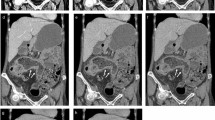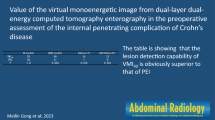Abstract
Objectives
To determine the optimal keV on dual-layer, dual-energy CT enterography (dlDE-CTE) and to investigate the added value of virtual monoenergetic images (VMIs) for the diagnosis of active Crohn’s disease (CD).
Methods
We collected 76 patients (including 45 CD patients) who underwent dlDE-CTE. CD was diagnosed using ileocolonoscopy. Conventional polychromatic images (PCI) were reconstructed using an iterative reconstruction algorithm at 120 kVp, and VMI at 40 keV (VMI40), 55 keV (VMI55), and 70 keV (VMI70). Contrast-to-noise ratio (CNR) was compared using Kruskal-Wallis test. Three radiologists independently reviewed PCI and subsequently combined PCI and the optimized VMI for the diagnosis of active CD using a 5-point scale. Multi-reader multi-case receiver operating characteristic analysis was performed.
Results
Mean ± standard deviation of CNRs for both normal (13.6±6.5, 6.1±3.2, 2.0±2.1, 1.9±1.6; P<0.001) and abnormal (9.4±7.3, 6.5±4.8, 4.9±3.1, 3.7±2.3; P<0.001) bowels were significantly greatest on VMI40, followed by VMI55, VMI70, and PCI. When VMI40 were added to PCI, overall area-under-the-curve of the three radiologists was significantly improved from 0.891 to 0.951 for diagnosing active CD (P=0.009).
Conclusions
The lowest monoenergetic images (VMI40) provided the best CNR on dlDE-CTE. Furthermore, the diagnostic performance for diagnosing active CD can be significantly improved with the addition of VMI40.
Key Points
• CNR for both normal and abnormal bowel walls is greatest on VMI 40 .
• Subjective image quality on VMI 40 is better than those on PCI.
• When VMI 40 images are added to PCI, radiologists’ diagnostic performance can be improved.






Similar content being viewed by others
Abbreviations
- MDCT:
-
Multidetector CT
- CTE:
-
CT enterography
- DE:
-
Dual energy
- SDCT:
-
Spectral detector CT
- dlDE-CTE:
-
Dual-layer dual-energy CTE
- PCI:
-
Polychromatic image
- VMI:
-
Virtual monoenergetic image
- CNR:
-
Contrast-to-noise ratio
- ROC:
-
Receiver operating characteristic
- AUC:
-
Area under the curve
- ANOVA:
-
One-way analysis of variance
- SD:
-
Standard deviation
References
Ilangovan R, Burling D, George A, Gupta A, Marshall M, Taylor SA (2012) CT enterography: review of technique and practical tips. Br J Radiol 85:876–886
Raptopoulos V, Schwartz RK, McNicholas MM, Movson J, Pearlman J, Joffe N (1997) Multiplanar helical CT enterography in patients with Crohn's disease. AJR Am J Roentgenol 169:1545–1550
Boudiaf M, Jaff A, Soyer P, Bouhnik Y, Hamzi L, Rymer R (2004) Small-bowel diseases: prospective evaluation of multi-detector row helical CT enteroclysis in 107 consecutive patients. Radiology 233:338–344
Maglinte DD, Sandrasegaran K, Lappas JC, Chiorean M (2007) CT enteroclysis. Radiology 245:661–671
Fletcher JG (2009) CT enterography technique: theme and variations. Abdom Imaging 34:283–288
Elsayes KM, Al-Hawary MM, Jagdish J, Ganesh HS, Platt JF (2010) CT enterography: principles, trends, and interpretation of findings. Radiographics 30:1955–1970
Qiu Y, Mao R, Chen BL et al (2014) Systematic review with meta-analysis: magnetic resonance enterography vs. computed tomography enterography for evaluating disease activity in small bowel Crohn's disease. Aliment Pharmacol Ther 40:134–146
Greenup AJ, Bressler B, Rosenfeld G (2016) Medical imaging in small bowel Crohn's disease-computer tomography enterography, magnetic resonance enterography, and ultrasound: "which one is the best for what?". Inflamm Bowel Dis 22:1246–1261
Furukawa A, Saotome T, Yamasaki M et al (2004) Cross-sectional imaging in Crohn disease. Radiographics 24:689–702
Yeh BM, Shepherd JA, Wang ZJ, Teh HS, Hartman RP, Prevrhal S (2009) Dual-energy and low-kVp CT in the abdomen. AJR Am J Roentgenol 193:47–54
Darras KE, McLaughlin PD, Kang H et al (2016) Virtual monoenergetic reconstruction of contrast-enhanced dual energy CT at 70keV maximizes mural enhancement in acute small bowel obstruction. Eur J Radiol 85:950–956
Kaza RK, Platt JF, Al-Hawary MM, Wasnik A, Liu PS, Pandya A (2012) CT enterography at 80 kVp with adaptive statistical iterative reconstruction versus at 120 kVp with standard reconstruction: image quality, diagnostic adequacy, and dose reduction. AJR Am J Roentgenol 198:1084–1092
Morgan DE (2014) Dual-energy CT of the abdomen. Abdom Imaging 39:108–134
Huda W, Ogden KM, Khorasani MR (2008) Converting dose-length product to effective dose at CT. Radiology 248:995–1003
Bodily KD, Fletcher JG, Solem CA et al (2006) Crohn disease: mural attenuation and thickness at contrast-enhanced CT Enterography--correlation with endoscopic and histologic findings of inflammation. Radiology 238:505–516
Booya F, Fletcher JG, Huprich JE et al (2006) Active Crohn disease: CT findings and interobserver agreement for enteric phase CT enterography. Radiology 241:787–795
Potretzke TA, Brace CL, Lubner MG, Sampson LA, Willey BJ, Lee FT Jr (2015) Early small-bowel ischemia: dual-energy CT improves conspicuity compared with conventional CT in a swine model. Radiology 275:119–126
Ploussi A, Alexopoulou E, Economopoulos N et al (2014) Patient radiation exposure and image quality evaluation with the use of iDose4 iterative reconstruction algorithm in chest-abdomen-pelvis CT examinations. Radiat Prot Dosim 158:399–405
Conover WJ (1999) Practical nonparametric statistics, 3rd edn. Jonh Wiley & Sons, New York
Dorfman DD, Berbaum KS, Metz CE (1992) Receiver operating characteristic rating analysis. Generalization to the population of readers and patients with the jackknife method. Investig Radiol 27:723–731
Hillis SL, Berbaum KS, Metz CE (2008) Recent developments in the Dorfman-Berbaum-Metz procedure for multireader ROC study analysis. Acad Radiol 15:647–661
Kambadakone AR, Chaudhary NA, Desai GS, Nguyen DD, Kulkarni NM, Sahani DV (2011) Low-dose MDCT and CT enterography of patients with Crohn disease: feasibility of adaptive statistical iterative reconstruction. AJR Am J Roentgenol 196:W743–W752
Gandhi NS, Baker ME, Goenka AH, Bullen JA, Obuchowski NA, Remer EM et al (2016) Diagnostic accuracy of CT enterography for active inflammatory terminal ileal Crohn disease: comparison of full-dose and half-dose images reconstructed with FBP and half-dose images with SAFIRE. Radiology 280:436–445
Funding
This study was supported by the Basic Science Research Program through the National Research Foundation of Korea [NRF] funded by the Ministry of Science, ICT & Future Planning (2016R1A2B4007762) and by the Research Program 2017 funded by Seoul National University College of Medicine Research Foundation (800-20170128).
Author information
Authors and Affiliations
Corresponding author
Ethics declarations
Guarantor
The scientific guarantor of this publication is Se Hyung Kim.
Conflict of interest
The authors of this manuscript declare no relationships with any companies, whose products or services may be related to the subject matter of the article.
Statistics and biometry
No complex statistical methods were necessary for this paper.
Informed consent
Written informed consent was waived by the Institutional Review Board.
Ethical approval
Institutional Review Board approval was obtained.
Methodology
• retrospective
• observational
• performed at one institution
Rights and permissions
About this article
Cite this article
Lee, S.M., Kim, S.H., Ahn, S.J. et al. Virtual monoenergetic dual-layer, dual-energy CT enterography: optimization of keV settings and its added value for Crohn’s disease. Eur Radiol 28, 2525–2534 (2018). https://doi.org/10.1007/s00330-017-5215-z
Received:
Revised:
Accepted:
Published:
Issue Date:
DOI: https://doi.org/10.1007/s00330-017-5215-z




